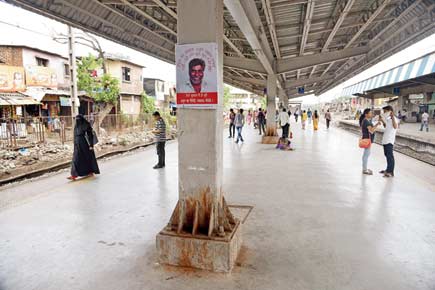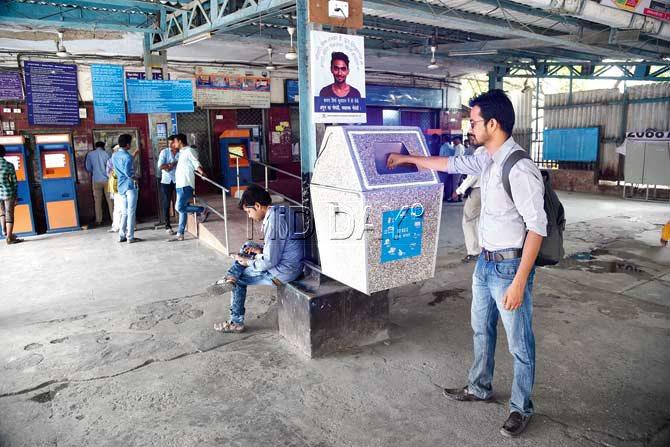After being designated as one of the dirtiest stations in Mumbai, a campaign called Apun Ka Govandi is now giving the station a much-needed makeover

“Till about a month ago, you wouldn’t have been able to stand at this spot because of the unbearable stench,” says Chintan Kantute, as we meet him next to the ticket counter at Govandi station. Kantute is a senior business development manager at Sampurn(e)arth Environment Solutions.

Far from stinking, the concourse and platforms are gleaming and there’s no sign of litter anywhere, but there are paan stains everywhere. Pics/Sameer Markande
ADVERTISEMENT
Sitting on a heap of garbage, by a choked, slushy sewage line, Govandi station was designated one of the dirtiest stations in Mumbai in a recent audit by Mumbai Rail Vikas Corporation (MRVC).

Smart bins made from recycled plastic wrappers and tetra packs that make clapping, cheering sounds when litter is thrown inside
It was to correct this infamous reputation that MRVC commissioned Sampurn(e)arth, a waste management company based in Chembur, to design a clean-up plan as well as a long-term waste management system for the station.
These days, the station, which sees more than 70,000 commuters hop on and off the Mumbai local every day, wears a much cleaner look. Far from stinking, the concourse and platforms are gleaming and there’s no sign of litter anywhere.
Sense of belonging
The clean-up campaign was launched on June 5 to coincide with World Environment Day. Titled Apun Ka Govandi, the campaign seeks to build a sense of belonging and shared ownership among local residents.
The station pillars are dotted with posters that feature portraits of actual residents working and living around Govandi station. The text, crafted in vernacular slang reads, ‘Govandi yek number hai poore Hindustan mein, kachra-wachra phekne ka khaali kudadan (dustbin) mein.’ “We have deliberately used tapori lingo because this is language the locals can relate to. While interacting with slum dwellers around, we realised that most of them couldn’t make sense of the railway announcements,” says Kantute, who along with his team spent two months interacting with residents. He reveals that the surveys conducted at Govandi Station confirmed the fact that station users perceive the place as being dirty and littered, but wouldn’t do much about it. “Because they would see people throwing garbage, they thought it was alright to do so,” he says. The toilets were so filthy that nobody dared to enter, instead preferring to defecate outside, says Kantute. “It took us 15-20 days to get clean up the platform and foot-over-bridge,” he adds. The company, which was founded in 2010, has now employed 5 staffers for this job every day.
Interestingly, along with railway announcements, the authorities have also been asked to play catchy jingles crafted by Sampurn(e)arth, encouraging people to segregate waste. “The posters and jingles aim to educate people about the importance of proper waste disposal and segregation in a fun, light-hearted way,” says campaign manager Pravin Madur, while showing us the separate bins they have installed for dry and wet waste. While earlier, there were only two bins on the platform placed by shopkeepers, currently there are about 11 bins and 2 smart bins (made from recycled plastic wrappers and tetra packs) which make clapping, cheering sounds when litter is thrown inside. “Earlier, we would only find 200 grams of waste in the bin, but now it’s up to half a kg,” says Madur.
The company has also embarked on a zero waste policy, so most of the waste is either recycled or sent to compost pits being built within the station.
Kankute feels that the reason Govandi station has acquired a notorious reputation is because it has been neglected in comparison to other stations on the Harbour line, despite receiving higher footfalls than Kurla. “Most people who live here are labourers, cabbies and bais (maidservants). Also, there’s a clear divide demographically. While the east has posher localities, the west is full of slums, and two sections keep blaming each other for the mess,” he explains.
The team says they avoided shaming residents and instead used positive reinforcement to persuade them to put in effort. “We made them realise that it’s a united effort, and that everyone in the area stands to gain from it,” adds Kankute.
Paan stains
But there is one persistent problem that threatens the station’s new squeaky-clean image — paan stains. As we walk along the foot-over-bridge, we realise the month-old paint job done by the railways is now full of spit marks. “Spit marks are toughest to get rid of. I have to spend an hour to clean up a small patch of paan spit,” says Zaheera Jameel Shaikh, a volunteer who has been cleaning the station for two months. The team now plans to suggest the MRVC to recruit a patrol squad to keep an eye on people and discourage them from spitting. “Our female volunteers sometimes face trouble from hooligans, but we plan to intimate authorities about this and beef up security in this area to curb such instances,” says Kantute.
 Subscribe today by clicking the link and stay updated with the latest news!" Click here!
Subscribe today by clicking the link and stay updated with the latest news!" Click here!







